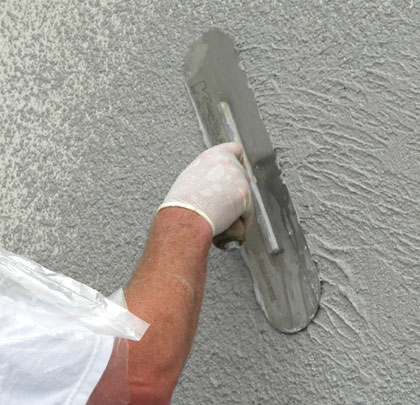Tougher-than-concrete exterior coating over foam-based substrates protects property owners and contractors
The exterior vertical surfaces of a building can take a beating. But in today’s climate of increasing construction-defect lawsuits, that “beating” can extend right to the contractor’s business. Stronger defenses must be adopted, and they begin with a reexamination of existing exterior coating options available.
With all the threats to a structure’s exterior, building owners deserve a coating that can essentially serve as a structural “suit of armor” against all types of damage, regardless of the underlying layers.
BUSINESS AS USUAL, NOT STRONG ENOUGH
For years, contractors have relied on exterior finishes which manage to “do the job,” but not much else. While these methods are widely employed—and look sufficiently acceptable upon application—they each pose their own drawbacks in terms of long-term durability.
Polystyrene-Based Exterior Finishing Systems, also known as synthetic stucco and EIFS, consist of an integrated composite material system that provides exterior walls with an insulated, finished surface. EIFS systems are appealing due to high thermal insulation and light weight. However, since the topcoat can be applied as thin as 1/32 of an inch, the result is an exterior that is soft to the touch. Unfortunately, this thin protective layer invites damage from even the most innocuous sources.
Some EIFS systems do offer a heavy-duty reinforcing mesh to increase the strength of the coating for high impact areas, but it is expensive ($1.50+/sq. ft.) and with multiple additional steps and layers of concrete, takes longer to install.
The other polystyrene-based product that is emerging for both commercial and residential construction is ICF (insulated concrete forms). ICF, which is made of a much harder form of polystyrene than EIFS, however, still requires an exterior coating of stucco, brick, or siding.
When it comes to tough exterior coating, perhaps the most widespread is conventional stucco. Yet, the use of stucco entails some tradeoffs. Today, stucco is increasingly applied in a single layer application. Depending on the area of the country, the substrate could be foam, or for tougher options CMU block or cement board. Beyond the fact that both options make for a very heavy coating, they may be more expensive options.
Although conventional three-layer stucco is quite tough and prevents some impact damage, there are other alternatives that are even tougher.
TOUGHER THAN CONCRETE
Today’s market now offers building materials so tough they are twice as hard as concrete and traditional, three-layer stucco. So tough it can even stop a bullet.
Perhaps the best balance of overall cost and sheer toughness is the PermaCrete system, available from the company of the same name. Not quite a newcomer to the market, but an increasingly adopted option if only because of its superior strength-to-cost ratio. At an installation price comparable to conventional three-layer stucco, this option represents one of the strongest, most durable coating products available.
Independent impact tests show that the product meets the requirements for “ultra high impact resistance of 220 in-lbs at a typical 3/8-inch application—enough to be “bullet resistant” at the outer surface, with only minimal cosmetic damage. In comparison to other common building and finishing materials, other tests show the many other options are only 50 percent as strong, with most well below that number.
One of the primary reasons for the product’s strength is it contains 70 to 100 percent more Portland cement coupled with a proprietary bonding agent. Most other plaster and synthetic stucco products contain little, if any, Portland.
The PermaCrete vertical system is comprised of a Matrix Mix (polymer modified cement), which is mixed with a proprietary bonding additive that increases durability and adherence; fiber mesh; and a sealer that can be clear or tinted. It can be applied by hawk and trowel or spray gun to many substrates, including concrete, masonry, foam, steel, stucco, and aggregate. Use of the product helps a contractor accumulate LEED points due to the fact that is contains no VOC’s (volatile organic compounds).
The system is available in hundreds of colors—including color codes from major commercial paint manufacturers—as well as in various patterns and textures.
Jim Huffman, owner of Concrete Rescue located in Roanoke, Virginia, a company that specializes in repairing aged and damaged concrete surfaces, has seen PermaCrete’s toughness up close. He regularly uses it both for overlayment and vertical surfaces.
Huffman recalls a major storm with golf-ball size hail that came through a local lakeside resort area several years ago. He was called in to inspect and repair any damage that might have occurred to one of the buildings.
“Every exterior in the neighborhood was beaten to a pulp,” says Huffman, who documented the damage with his camera. However, he found only minimal damage to the single building clad in PermaCrete.
To prove its durability over synthetic and conventional stucco, contractors have improvised a variety of unique demonstrations to show customers, ranging from shooting nail guns at the surface from close distance, throwing a baseball at the wall, and even pounding on it with a hammer.
For Shane Olivarez of Certified Concrete Designs located in Rochester, Indiana, a company that does horizontal and vertical applications across the U.S., putting PermaCrete over a product like ICF makes for a product that, with a proper roof, could withstand an F5 tornado.
“It might suck the windows out of it, it might pull the doors off, but your structure will still be there,” says Olivarez.
As far as the contractor is concerned, getting served a complaint for a construction defect lawsuit is like getting slammed by an F5 tornado—all the more reason to seek the toughest protection available.
■ ■ ■
[divider]
For More Information For more information, contact PermaCrete at 800.607.3762, or visit www.permacrete.com.
Modern Contractor Solutions, July 2014
Did you enjoy this article?
Subscribe to the FREE Digital Edition of Modern Contractor Solutions Magazine!


